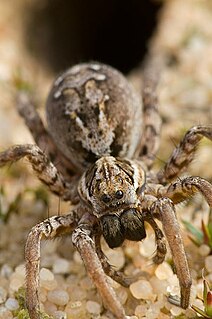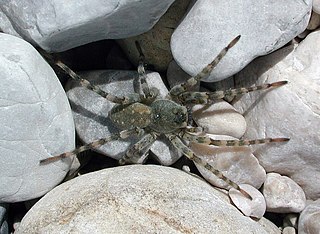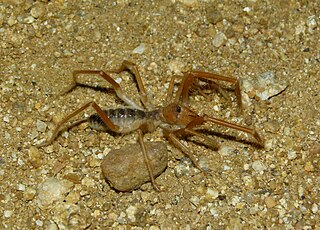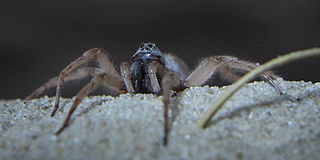
Wolf spiders are members of the family Lycosidae, from the Ancient Greek word "λύκος" meaning "wolf". They are robust and agile hunters with excellent eyesight. They live mostly in solitude and hunt alone, and do not spin webs. Some are opportunistic hunters pouncing upon prey as they find it or even chasing it over short distances. Some wait for passing prey in or near the mouth of a burrow.

Alopecosa is a spider genus in the family Lycosidae, with about 160 species. They have a largely Eurasian distribution, although some species are found in North Africa and North America.

Arctosa is a genus of wolf spiders first described by Carl Ludwig Koch in 1847. As of February 2019 it contains 169 species.

Galeodes is a genus of solifuges or sun spiders. The nearly 200 species in this genus are found in northern Africa, southeastern Europe and Asia. Like other solifuges, they are mainly nocturnal and found in arid habitats. They often have long hairy appendages and are not as stout bodied or dark and contrastingly coloured as some other solifuges. Some Galeodes species are able to produce sounds by stridulation. These are usually raspy or hiss-like and may be imitations of the sounds of vipers, to serve a defensive function. As in other solifuges, mating involves the male depositing a spermatogonia that is manipulated into the female genital opening using their chelicera. The male strokes the female using the palps allowing her to be approached. Females will often feed on males before or after mating. The female then deposits the eggs in a burrow in soil and in some species guards them.

Allocosa is a spider genus of the wolf spider family, Lycosidae. The 130 or more recognized species are spread worldwide.

Trochosa is a large wolf spider genus found worldwide.

Hippasa is a genus of wolf spiders in the family Lycosidae, containing thirty five accepted species.
Agalenocosa is a genus of spiders in the family Lycosidae. It was first described in 1944 by Mello-Leitão. As of 2017, it contains 18 species with a wide distribution.
Caporiaccosa is a genus of spiders in the family Lycosidae. It was first described in 1960 by Roewer. As of 2017, it contains only one species, Caporiaccosa arctosaeformis, found in Ethiopia.
Diahogna is a genus of spiders in the family Lycosidae. It was first described in 1960 by Roewer. As of 2017, it contains 4 Australian species.
Dolocosa is a genus of spiders in the family Lycosidae. It was first described in 1960 by Roewer. As of 2017, it contains only one species, Dolocosa dolosa, on the island of Saint Helena.
Evippomma is a genus of spiders in the family Lycosidae. It was first described in 1959 by Roewer. As of 2017, it contains 6 species.

Geolycosa is a genus of wolf spiders first described in 1904.

Hoggicosa is a genus of wolf spiders first described by Carl Friedrich Roewer in 1960. The name is a reference to arachnologist Henry Roughton Hogg.
Molitorosa is a genus of spiders in the family Lycosidae. It was first described in 1960 by Roewer. As of 2017, it contains only one Brazilian species, Molitorosa molitor.
Orinocosa is a genus of spiders in the family Lycosidae. It was first described in 1916 by Chamberlin. As of 2017, it contains 9 species.
Pavocosa is a genus of spiders in the family Lycosidae. It was first described in 1960 by Roewer. As of 2017, it contains 5 species.
Proevippa is a genus of spiders in the family Lycosidae. It was first described in 1903 by Purcell. As of 2017, it contains 11 African species.

Tetralycosa is a genus of Australian spiders in the family Lycosidae first described by Roewer in 1960, later revised by Framenau & Hudson to include thirteen species. Genetic studies show that these spiders all diverged from a common ancestor who likely wandered into the salty area and remained. They live exclusively in certain saline environments of Australia's interior, including coastal beaches, mound springs, clay pans, and salt lakes. There haven't been enough studies to establish a conservation status, but some species have only been found in solitary salt lakes, suggesting that the increase of mining, agriculture, recreational, and similar disturbances of these unique ecosystems may eventually lead to their extinction if not properly regulated.
Trochosippa is a genus of spiders in the family Lycosidae. It was first described in 1960 by Roewer. As of 2017, it contains 9 species.









